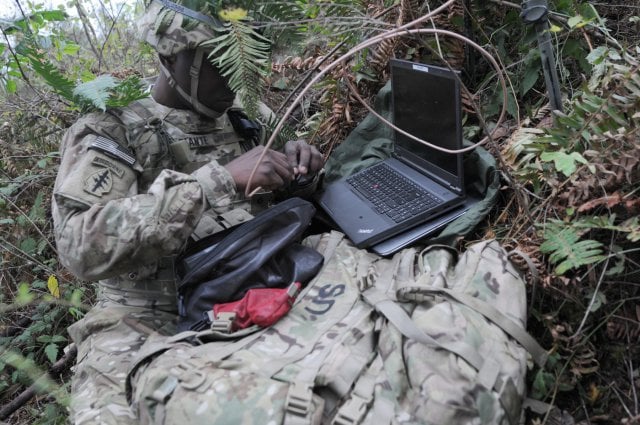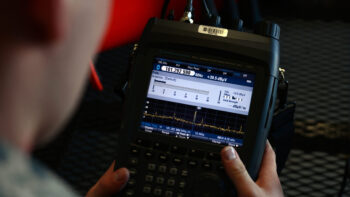
A soldier from the Army’s offensive cyber brigade during an exercise at Fort Lewis, Washington, which will be one of the Pentagon’s four pilot sites for new 5G networks.
PENTAGON: Close to 300 companies logged on to a “virtual industry day” with Pentagon leadership last week as the military scrambles to build its own 5G networks. The challenge: moving fast enough to keep up with commercial innovation — but cautiously enough to keep China out.
The event, led by DoD’s technical director for 5G, Dr. Joe Evans, marked a starting point for shaping a forthcoming Request for Prototype Proposals planned in the coming weeks. The companies selected will then start work later this year on a series of 5G experiments at four bases across the United States.
Those experiments are intended to help the individual armed services to refine what it is they need, and what they need to ask from industry, as the Pentagon pumps hundreds of millions of new funding into 5G programs across the department.
The experiments run the gamut from logistics to sharing information between radar systems, and each service will play a role in testing out what industry offers. Hill Air Force Base in Utah will develop 5G dynamic spectrum sharing capabilities between airborne radar systems and 5G cellular systems. The Marine Corps Logistics Base Albany, Georgia and Naval Base San Diego will test out a smart warehouse concept, while virtual reality training systems will be tested at Joint Base Lewis-McChord, Washington.
The RPP will be issued through the National Spectrum Consortium, an industry group established under a five-year, $1.25 billion Other Transaction Authority contract with the Deputy Assistant Secretary of Defense, Emerging Capabilities and Prototyping. Only vetted companies who belong to the consortium will be considered for the work.
The effort is part of a wider push within the government to develop homegrown tech, and quickly. President Trump’s top economic advisor, Larry Kudlow, told reporters Friday the White House is planning a 5G meeting in April with top technology companies in an effort to ensure Huawei does not cornere the global market on the technology. “We’re going to have a lot of them in the White House to have a discussion,” Kudlow said, though the event hasn’t been officially announced.
The Pentagon fiscal year 2021 budget requests $449 million in research and development for the 5G next generation information communications technology program, $249 million more than provided by Congress last year.
While the Pentagon is paying to run these initial tests, the individual services will ultimately be responsible for paying to 5G technologies once they’re matured, adding another budget line at a time when no one expects defense accounts to rise for the foreseeable future.
When that happens, 5G will compete “with all other infrastructure upgrades that the services already have planned for their installations and for the systems that operate on them,” said Morgan Dwyer, a former Pentagon official now at the Center for Strategic and International Studies. “So, how quickly DoD can deploy 5G is really a function of how much utility the technology provides to the services and how willing they are to trade-off other capabilities in order to prioritize 5G instead.”
Australia unveils ‘historic’ defense boost to 2.4% of GDP in decade, but critics say too little, too late
Part of the shakeup includes tens of billions for nuclear-powered subs, and halting the pricey procurement of an additional F-35 fighter jet squadron.



























